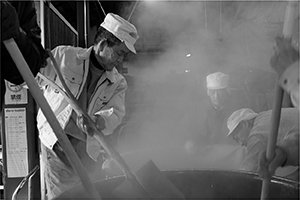- ホーム
- English

Tanba, Oishi’s Kimoto Sake

Kimoto is a natural technique established in the Edo Era that skillfully uses microorganisms to grow a high-quality yeast. Kimoto is a technique for growing yeast. Kimoto is a process where cooling steamed rice, kome-koji (rice with specific mold spores for sake brewing) and shikomi-sui water (water for sake brewing) are ground together for several hours in the midnight of the coldest season in a process referred to as “motosuri” or “yama-oroshi.” Next in a step called “utase,” the brew is aged at low temperatures for three days, then warmed up little by little via a hot-water keg, purifying the sake yeast. It is an incredibly complex process. Oishi Sake Brewery doesn’t use machines, but instead relies on the techniques of the chief brewer to make handmade local sake.
History of Oishi Sake Brewery?
Genroku Era (1688 - 1704)
The first generation of brewers, Tarobe Oishi, set up a branch family from the village headman and founded the brewery.
1872 『Tarobe Sakeya』 changed its name to 『Sakakiya』.
1920 Started selling to consumers under the trademark 『Kinsei』.
1955 Added a new trademark, 『Okinazuru』, to further commercialization. Expanded sales from the whole Kinki region to Tokyo, Kyushu and Nagoya.
1964 Opened a Kyoto sake store called 『Okinazuru』 in Shimbashi, Tokyo.
1975 Opened a yakitori (skewered grilled chicken) restaurant called 『Okinazuru』 in Kameoka, Kyoto.
1989 Started a sake brewery tour called 『Sake-no-Yakata』.
1993 Expanded Yagi-gura (manufacturing plant).
1995 Opened 『Shukian』 tearoom and specialty goods store.
2006 Opened a sake store called 『Sake-no-Yakata』, in front of Kameoka Station.
2014 Newly established 「Miyama-ji Sake-no-Yakata」 and Miyama-gura (manufacturing plant) in Kyoto.

Making sake for 300 years in the beautiful and abundant nature of Tanba, since the Genroku Era
Tours of Oishi Brewery’s directly operated Sake-no-Yakata, its headquarters and main brewery are available.
The traditional techniques of handmade sake. Taste Tanba sake at its origin.
| Tour content | 1F Bottling plant and direct sales store, 2F Sake-making exhibition room |
|---|---|
| Store Hours | 9:00 - 17:00 |
| Tour of a sake brewery opening hours | 9:00 - 17:00 (We ask that you arrive by 3:30 p.m. for the brewery tour.) |
| Parking | Capacity for 10 large buses or 50 passenger cars |
| Holiday | Open every day (except midsummer Obon holiday and New Year’s Day)/Tours are free |
Access
OISHI SHUZOU Tanba-ji Sake-no-Yakata (Main brewery)
Kakiuchimata13, Hiedanocho Saeki, Kameoka-shi, Kyoto, 621-0033, Japan
TEL:+81 771-22-0632 FAX:+81 771-23-2188
Corporate Philosophy
 In the climate and natural features of Tanba and the luxurious natural setting of the rural district, Kameoka, during the Genroku Period (in the Edo Era), Tarobe Oishi set up a branch family from the village headman and established Tarobe Sakeya. Then, in the Meiji Era, under the name of Sakakiya, it began serving its local sake to people in the region.
In the climate and natural features of Tanba and the luxurious natural setting of the rural district, Kameoka, during the Genroku Period (in the Edo Era), Tarobe Oishi set up a branch family from the village headman and established Tarobe Sakeya. Then, in the Meiji Era, under the name of Sakakiya, it began serving its local sake to people in the region.From the Taisho to the Showa eras, it did business under the Azuma Sakaya name. After World War II, it changed to its current name of Oishi Sake Brewery.Tanba has long been a source of excellent grains. The characters in its name imply a “red wave,” denoting a mecca of rice (that ripens to a golden yellow). It’s a famous spot whose very name is synonymous with Japan’s countryside. The original landscape of a village in the foothills is unchanged from long ago. This area, near the cities of Kobe, Osaka and Kyoto, tends to put people at ease.
Flowing through the middle is the Kami-katsura River (part of the Hozugawa River), whose source is the Kitayama watershed famous for its Kitayama cedars. It’s a pure river that stretches to Mt. Arashiyama. Old sake breweries (with space for storage) are built along this river. Every year from autumn to spring since operations began about 300 years ago, Tanba’s veteran sake brewers make sake in the traditional way in the cold of winter.From October 2014, we began looking for a better spot to make sake and found a place known as Kayabuki-no-Sato.
It’s a beautiful place in Miyamacho, South Tanba, Kyoto, and we established a brewery there. It’s a convenient place for making sake, with access to the source of Miyama River’s water. It’s also the perfect temperate environment for kimoto process, and devoting oneself to making sake one bottle at a time.
Our motto is “making our customers happy, one person at a time, with local Tanba sake. We’re a small, but spirited company shining its light into the 21st century and sending Tanba sake around the world via the Internet. Under the Tanba originated SAKE brand, we’re out to challenge ourselves in global markets.
